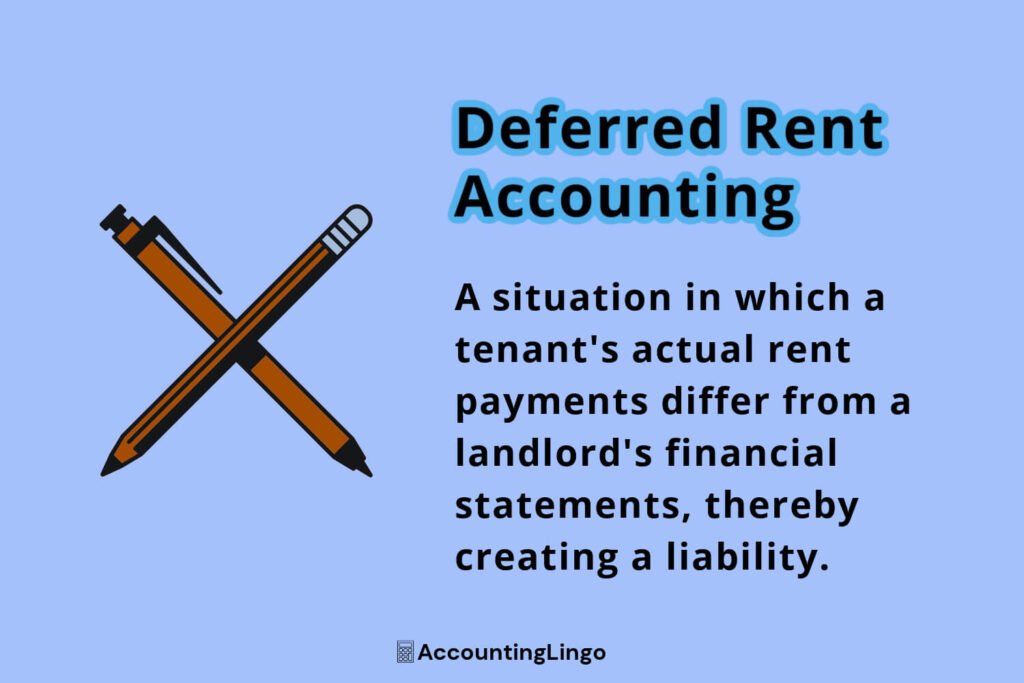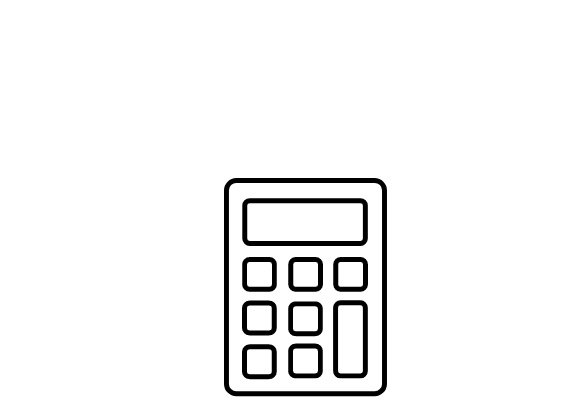
In accounting, deferred rent can be a complex concept to grasp. Whether you’re a small startup or a large corporation, understanding deferred rent is crucial for accurate financial reporting and decision-making.
This guide will help explain accounting for deferred rent and provide you with the knowledge and tools you need to navigate this financial topic.
What is Deferred Rent Accounting?
Deferred rent, also known as rent expense, means the difference between the contractual rent and the straight-line rent expense recognized over the lease term. In other words, it represents the imbalance between the rent payments made and the expense recognized.
This imbalance occurs when the lease agreement specifies that rent payments be unevenly distributed over the lease term. This situation commonly occurs when a tenant is provided free rent during one or more periods. Therefore, this may transpire at the beginning of a new lease agreement.
To account for deferred rent, businesses need to understand the concept of a straight-line rent expense schedule. This is calculated by dividing the total rent expense over the lease term equally across each reporting period.
This allows businesses to allocate the rent expense evenly over the lease term, providing a more accurate representation of the financial impact of the lease. Leases of 12 months or less are recognized as expenses utilizing the straight-line method. Due to newer regulations affecting deferred rent such as ASC 842, leases that are greater than 12 months are to be recognized on the balance sheet.
Recognizing deferred rent ensures business’s financial statements accurately reflect the true cost of leasing. This is especially important for companies with long-term lease agreements, as the impact of deferred rent can be significant.
Leases Requiring Deferred Rent Accounting
Deferred rent accounting is typically required for leases, including uneven rent payments over the lease term. These leases are often referred to as operating leases, where rental payments often vary from period to period. Furthermore, operating leases are commonly used for office spaces, aircraft, office equipment, and other types of commercial property with long life spans.
On the other hand, leases that include equal rent payments over the lease term are referred to as finance leases or capital leases. A finance lease differs from an operating lease in terms of accounting treatment since it involves the transfer of ownership rights and responsibilities to the lessee.
This guide will focus on deferred rent accounting for operating leases, as it is more complex and requires specific calculations to record and report deferred rent accurately. GAAP rules dictate the accounting for operating leases.
Calculating & Recording Deferred Rent
Calculating and recording deferred rent requires a systematic approach to ensure accuracy and compliance with accounting principles. The process involves the following steps:
1. Determine Total Rent Expense
To calculate the total rent expense, businesses need to consider the lease term, rental payments, and any additional costs or incentives specified in the lease agreement.
2. Calculate Rent Expense
Once the total rent expense is determined, businesses can calculate the straight-line rent expense by dividing the total rent expense equally over each reporting period.
3. Determine Deferred Rent Balance
The deferred rent balance is the difference between the actual rent payments made and the straight-line rent expense recognized.
4. Deferred Rent Journal Entry
Businesses must record the deferred rent as a lease liability and a right-of-use asset on their balance sheet for leases greater than 12 months. For leases of 12 months or less, it’s recorded as an expense using the straight-line basis method.
By following these steps, businesses can accurately calculate and record deferred rent, ensuring compliance with accounting standards and clearly representing their financial position.
Reporting & Disclosure Requirements for Deferred Rent
Accurate reporting and disclosure of deferred rent are essential for businesses to provide transparent financial statements and comply with accounting standards. The following reporting and disclosure requirements should be considered when accounting for deferred rent:
Balance Sheet Presentation
Leases greater than 12 months are required to be recorded on the Balance Sheet as a lease liability and a right of use asset. Total rent expense is recognized on a straight-line basis.
Notes to Financial Statements
Businesses should include detailed disclosures about their deferred rent accounting policies and the significant assumptions and judgments used in calculating deferred rent. Doing so helps financial statement users understand the nature and impact of deferred rent on the business’s financial position.
Footnote Disclosures
Additional information regarding the lease agreements, including the lease term, rental payments, and any incentives or concessions provided, should be disclosed in the footnotes to the financial statements. Doing so provides users with a comprehensive understanding of the lease arrangements and the related deferred rent.
Compliance with reporting and disclosure requirements ensures that businesses provide accurate and transparent financial statements, allowing stakeholders to make informed decisions with reliable information.
Challenges of Deferred Rent Accounting
Deferred rent accounting can be complex, and businesses often need help implementing and maintaining this accounting process. Some common challenges include:
Understanding Lease Agreements
Lease agreements can be complex, with various terms and conditions that impact the calculation and recording of deferred rent. Therefore, businesses must carefully review and interpret lease agreements to ensure accurate accounting.
Estimating Lease Term
Determining the lease term is crucial for calculating the total and straight-line rent expenses. However, estimating the lease term can be challenging, especially when lease agreements include options to extend or terminate the lease.
Rent Payments Collectibility
Businesses need to assess the collectibility of rent payments when calculating deferred rent. This requires judgment and consideration of factors such as the lessee’s financial stability and the likelihood of lease defaults.
Updates to Accounting Standards
Accounting standards related to leases, including deferred rent accounting, are subject to change. Therefore, businesses need to stay updated on any changes to ensure compliance and accurate financial reporting.
To overcome these challenges, businesses should seek professional guidance and establish robust internal controls to ensure accurate and compliant deferred rent accounting.
Best Practices for Deferred Rent Accounting
Implementing and maintaining an effective deferred rent accounting process requires a proactive approach and adherence to best practices. Some key best practices include:
1. Establish Clear Policies
Businesses should develop clear and comprehensive accounting policies for deferred rent to ensure consistency and accuracy throughout financial reporting.
2. Invest in Lease Software
Lease accounting software can streamline deferred rent calculation, recording, and reporting. It automates complex calculations, reduces manual errors, and provides real-time visibility into lease-related financial data.
3. Regularly Review Leases
Businesses should regularly review lease agreements to ensure accurate accounting. This includes reviewing lease terms, rental payments, and any modifications or amendments to the lease agreements.
4. Conduct Periodic Audits
Periodic lease audits can help businesses identify discrepancies or errors in calculating and recording deferred rent. In addition, audits provide an opportunity to review lease data, validate calculations, and ensure compliance with accounting standards.
By following these best practices, businesses can reduce errors and maintain accurate and compliant financial reporting.
Tools & Software
Managing deferred rent accounting can be challenging without the right tools and software. Fortunately, there are several solutions available that can simplify the process and ensure accuracy. Some popular tools and software include:
Lease Accounting Software
Lease accounting software automates the calculation and recording of deferred rent, streamlining the entire process. Furthermore, it provides real-time visibility into lease data, generates accurate financial reports, and ensures compliance with accounting standards.
Spreadsheet Templates
Businesses can use spreadsheet templates designed explicitly for lease-related accounting. These templates include pre-built formulas and calculations, making the process of calculating and tracking deferred rent much easier.
Choosing the right tool or software depends on the specific needs and requirements of the business. Moreover, it’s important to assess different options’ features, functionality, and compatibility before deciding.
Conclusion
Whether you’re a small startup or a large corporation, it’s important to take the time to understand deferred rent accounting. Accurate and compliant deferred rent accounting is crucial for financial transparency, informed decision-making, and long-term success.
Additional Resources
Other helpful articles may include:
Non-Depreciable Assets Explained
Why is Accounting Important?
What is a Partial Payment?
